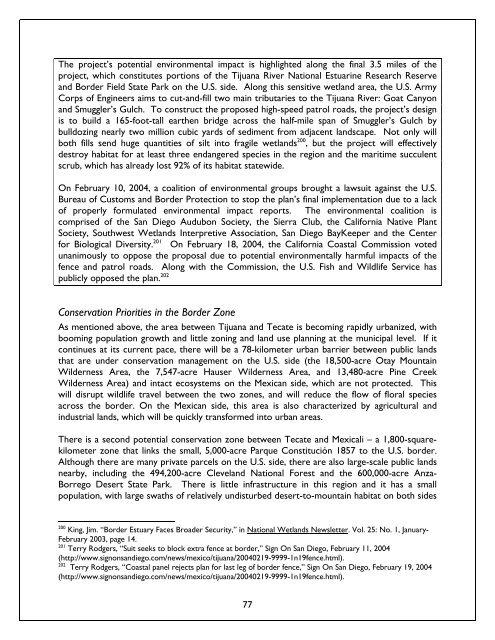Blurred Borders - International Community Foundation
Blurred Borders - International Community Foundation
Blurred Borders - International Community Foundation
You also want an ePaper? Increase the reach of your titles
YUMPU automatically turns print PDFs into web optimized ePapers that Google loves.
The project’s potential environmental impact is highlighted along the final 3.5 miles of the<br />
project, which constitutes portions of the Tijuana River National Estuarine Research Reserve<br />
and Border Field State Park on the U.S. side. Along this sensitive wetland area, the U.S. Army<br />
Corps of Engineers aims to cut-and-fill two main tributaries to the Tijuana River: Goat Canyon<br />
and Smuggler’s Gulch. To construct the proposed high-speed patrol roads, the project’s design<br />
is to build a 165-foot-tall earthen bridge across the half-mile span of Smuggler’s Gulch by<br />
bulldozing nearly two million cubic yards of sediment from adjacent landscape. Not only will<br />
both fills send huge quantities of silt into fragile wetlands 200 , but the project will effectively<br />
destroy habitat for at least three endangered species in the region and the maritime succulent<br />
scrub, which has already lost 92% of its habitat statewide.<br />
On February 10, 2004, a coalition of environmental groups brought a lawsuit against the U.S.<br />
Bureau of Customs and Border Protection to stop the plan’s final implementation due to a lack<br />
of properly formulated environmental impact reports. The environmental coalition is<br />
comprised of the San Diego Audubon Society, the Sierra Club, the California Native Plant<br />
Society, Southwest Wetlands Interpretive Association, San Diego BayKeeper and the Center<br />
for Biological Diversity. 201 On February 18, 2004, the California Coastal Commission voted<br />
unanimously to oppose the proposal due to potential environmentally harmful impacts of the<br />
fence and patrol roads. Along with the Commission, the U.S. Fish and Wildlife Service has<br />
publicly opposed the plan. 202<br />
Conservation Priorities in the Border Zone<br />
As mentioned above, the area between Tijuana and Tecate is becoming rapidly urbanized, with<br />
booming population growth and little zoning and land use planning at the municipal level. If it<br />
continues at its current pace, there will be a 78-kilometer urban barrier between public lands<br />
that are under conservation management on the U.S. side (the 18,500-acre Otay Mountain<br />
Wilderness Area, the 7,547-acre Hauser Wilderness Area, and 13,480-acre Pine Creek<br />
Wilderness Area) and intact ecosystems on the Mexican side, which are not protected. This<br />
will disrupt wildlife travel between the two zones, and will reduce the flow of floral species<br />
across the border. On the Mexican side, this area is also characterized by agricultural and<br />
industrial lands, which will be quickly transformed into urban areas.<br />
There is a second potential conservation zone between Tecate and Mexicali – a 1,800-squarekilometer<br />
zone that links the small, 5,000-acre Parque Constitución 1857 to the U.S. border.<br />
Although there are many private parcels on the U.S. side, there are also large-scale public lands<br />
nearby, including the 494,200-acre Cleveland National Forest and the 600,000-acre Anza-<br />
Borrego Desert State Park. There is little infrastructure in this region and it has a small<br />
population, with large swaths of relatively undisturbed desert-to-mountain habitat on both sides<br />
200<br />
King, Jim. “Border Estuary Faces Broader Security,” in National Wetlands Newsletter. Vol. 25: No. 1, January-<br />
February 2003, page 14.<br />
201<br />
Terry Rodgers, “Suit seeks to block extra fence at border,” Sign On San Diego, February 11, 2004<br />
(http://www.signonsandiego.com/news/mexico/tijuana/20040219-9999-1n19fence.html).<br />
202<br />
Terry Rodgers, “Coastal panel rejects plan for last leg of border fence,” Sign On San Diego, February 19, 2004<br />
(http://www.signonsandiego.com/news/mexico/tijuana/20040219-9999-1n19fence.html).<br />
77















